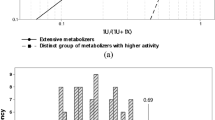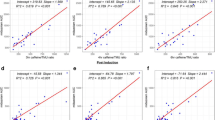Abstract
Objectives: To evaluate the in vivo effect of xanthine oxidase (XO) inhibition by allopurinol on the determination of polymorphic N-acetyltransferase 2 (NAT2) and cytochrome P450 1A2 (CYP1A2) with urinary caffeine metabolic ratios.
Methods: In an open, prospective study involving 21 healthy subjects (eight fast, 13 slow NAT2 acetylators) allopurinol (300 mg perday) was administered orally on trial days 1–8, followed by a wash-out period of 8 days. Urinary caffeine tests (200 mg caffeine p.o.) were performed repetitively. Urine was collected for 8 h and venous blood samples for the determination of allopurinol, oxypurinol and uric acid were drawn. The urinary caffeine metabolites 1-methyluric acid (1MU), 1-methylxanthine (1MX), 1,7-dimethyluric acid (17MU), 1,7-dimethylxanthine (17MX), 5-acetylamino-6-formylamino-3-methyluracil (AFMU), plasma allopurinol and oxypurinol were analysed using high-performance liquid chromatography (HPLC).
Results: During XO inhibition by allopurinol, the formation of 1MU from 1MX and therefore the XO ratio 1MU/1MX decreased to 15.9 (1.2)% [mean with (SEM)] of baseline values (P < 0.005). The NAT2 ratio AFMU/1MX decreased likewise to 56.7 (6.3)% (P < 0.005). AFMU/(AFMU + 1MX + 1MU), an alternative NAT2 ratio, remained constant, but the CYP1A2 ratio (AFMU + 1MX + 1MU)/17MU, used to express CYP1A2 activity, transiently increased to 167 (13)% (P < 0.005). The NAT2 phenotype did not influence CYP1A2 and XO ratios or plasma oxypurinol pharmacokinetics.
Conclusions: Several caffeine metabolic ratios are commonly used to express the activities of NAT2, CYP1A2 and XO both in healthy volunteers and in polymedicated patients, although their reliability has not been evaluated thoroughly during concurrent drug administration. The findings of this study suggest that NAT2 phenotyping should be performed using the ratio AFMU/(AFMU + 1MX + 1MU) if an XO inhibitor may be present. It also shows that the determination of CYP1A2 activity with caffeine as a metabolic probe is considerably altered under these conditions. Thus, concomitant drug administration may impair the robustness of multiple pathways of the complex caffeine test. This points to the need for alternative probes, designed to assess only the activity of a single enzyme because, in contrast to healthy volunteers, in patients known or unknown drug interactions may often be present.
Similar content being viewed by others
Author information
Authors and Affiliations
Additional information
Received: 10 August 1998 / Accepted in revised form: 5 October 1998
Rights and permissions
About this article
Cite this article
Fuchs, P., Haefeli, W., Ledermann, H. et al. Xanthine oxidase inhibition by allopurinol affects the reliability of urinary caffeine metabolic ratios as markers for N-acetyltransferase 2 and CYP1A2 activities. E J Clin Pharmacol 54, 869–876 (1999). https://doi.org/10.1007/s002280050569
Issue Date:
DOI: https://doi.org/10.1007/s002280050569




